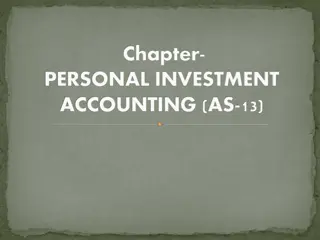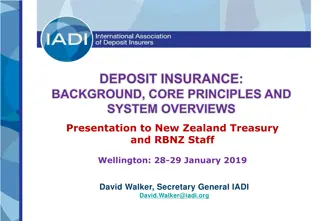Deposit and Investment Risk Disclosures for Accounting Professionals
Experienced Senior Auditor Michelle Kiese from BDO USA, Anchorage Office, discusses GASB 40 amendments and important risk disclosures related to credit risk, custodial credit risk, and concentrations of credit risk for deposit and investment transactions to provide users with valuable information for assessing common risks.
Download Presentation

Please find below an Image/Link to download the presentation.
The content on the website is provided AS IS for your information and personal use only. It may not be sold, licensed, or shared on other websites without obtaining consent from the author.If you encounter any issues during the download, it is possible that the publisher has removed the file from their server.
You are allowed to download the files provided on this website for personal or commercial use, subject to the condition that they are used lawfully. All files are the property of their respective owners.
The content on the website is provided AS IS for your information and personal use only. It may not be sold, licensed, or shared on other websites without obtaining consent from the author.
E N D
Presentation Transcript
DEPOSIT AND INVESTMENT DISCLOSURES Michelle Kiese Experienced Senior Auditor BDO USA, Anchorage Office BDO USA, LLP, a Delaware limited liability partnership, is the U.S. member of BDO International Limited, a UK company limited by guarantee, and forms part of the international BDO network of independent member firms.
GASB 40 Deposit & Investment Risk Disclosures Amendment of GASB Statement No. 3 Effective for Periods Beginning after June 15, 2004 Provide users with information to assess common risks inherent in deposit and investment transactions 5 Types of Risks and Disclosures for those Specific Risks Deposit & Investment Disclosures 2
Credit Risk The risk that an issuer or other counterparty to an investment will not fulfill its obligations. Provide information disclosing the credit quality ratings of investments in debt securities as described by nationally recognized statistical rating organizations. Unless there is information to the contrary, obligations of the US Government or obligations explicitly guaranteed by the US government are not considered to have credit risk. Disclose the credit ratings of external investment pools, money market funds, bond mutual funds, and other pooled investments of fixed-income securities. Disclosure is required and the investment is unrated, the disclosure should indicate that fact. Deposit & Investment Disclosures 3
Custodial Credit Risk The custodial credit risk for deposits or investments is the risk that, in the event of the failure of a depository financial institution or the counterparty to a transaction, a government will not be able to recover deposits, the value of the investment, or will not be able to recover collateral securities that are in the possession of an outside party. Deposits are exposed if they are not covered by depository insurance and the deposits are: - Uncollateralized, - Collateralized with securities held by the pledging financial institution (PFI), or - Collateralized with securities held by the PFI s Trust Department or Agent but not in the depository- government s name. Investment securities exposed to custodial credit risk if the securities are uninsured, are not registered in the name of the government, and are held by either the counterparty or counterparty s trust department or agent but not in the government s name. Deposit & Investment Disclosures 4
Concentrations of Credit Risk The risk of loss attributed to the magnitude of a government s investment in a single issuer. Provide information about the concentration of credit risk associated with investments by disclosing: - By amount and issuer, - Investments in any one issuer that represent 5% or more of total investments based on the level of detail. Investments issued or explicitly guaranteed by the US Government and investments in mutual funds, external investment pools, and other pooled investments are excluded from this requirement. Deposit & Investment Disclosures 5
Interest Rate Risk The risk that changes in interest rates will adversely affect the fair value of an investment. Disclose information about the interest rate risk for debt investments by investment type and amount using one of the following methods: - Segmented time distribution - Specific Identification - Weighted Average Maturity - Duration - Simulation Model Disclose the terms of investments with fair value that are highly sensitive to changes in interest rates. - Variable-rate Investments - Asset-backed Investments Deposit & Investment Disclosures 6
Foreign Currency Risk The risk that changes in exchange rates will adversely affect the fair value of an investment. Disclose the US Dollar Balances of such deposits or investments organized by currency denomination and, if applicable, investment type. Deposit & Investment Disclosures 7
General Disclosure Principles Unless otherwise required, investment disclosures should be organized by investment type, such as US Treasuries, corporate bonds, or commercial paper. Dissimilar investments, such as US Treasury Bills and US Treasury Strips, should not be aggregated into a single investment type. Disclosures generally should be made for the primary government, including its blended component units. Disclosures should also be made for governmental and business type activities, including major funds, or nonmajor funds in the aggregate when the risk exposures are significantly greater than the risks of the primary government. Disclosure is required for the deposit or investment policies related to these risks. Deposit & Investment Disclosures 8
GASB 72 Fair Value Measurement and Application Effective for Periods Beginning after June 15, 2015 Provides guidance for determining a fair value measurement and applying fair value to certain investments and disclosures related to all fair value measurements. Application and Disclosures of Fair Value Fair Value Hierarchy - 3 Levels of Inputs Deposit & Investment Disclosures 9
Fair Value Application and Disclosures An investment is defined as a security or other asset that : - A government holds primarily for the purpose of income or profit, and - Has a present service capacity based solely on its ability to generate cash or to be sold to generate cash. Investments not measured at fair value continue to include, for example: - Money market investments, - External investment pools, - Investments in life insurance contracts, - Common stock meeting the criteria for applying the equity method, - Unallocated insurance contracts, and - Synthetic guaranteed investment contracts. Deposit & Investment Disclosures 10
Fair Value Application and Disclosures, continued A government is permitted in certain circumstances to establish the fair value of an investment that does not have a readily determinable fair value by using the net asset value (NAV) per share (or its equivalent) of the investment. Requires measurement at acquisition value (at entry price) for donated capital assets, donated works of art, historical treasures, and similar assets and capital assets received in a service concession arrangement. Requires disclosures to made about the fair value measurements, the level of fair value hierarchy and valuation techniques. Disclosures should be organized by type of asset or liability reported at fair value. Requires additional disclosures regarding investments calculated at NAV per share (or its equivalent). Deposit & Investment Disclosures 11
Fair Value Hierarchy - 3 Level of Inputs Level 1 Inputs Are quoted prices (unadjusted) in active markets for identical assets or liabilities. Level 2 Inputs Are inputs, other than quoted prices, included within Level 1 that are observable for the asset or liability, either directly or indirectly. Level 3 Inputs Are unobservable inputs, such as management s assumptions of the default rate among underlying mortgages of a mortgage backed security. Deposit & Investment Disclosures 12
Disclosure Examples Deposit & Investment Disclosures 13
Resources GASB Website (https://www.gasb.org) - Standards and Guidance - Implementation Guides Deposit & Investment Disclosures 16
QUESTIONS? Deposit & Investment Disclosures 17























